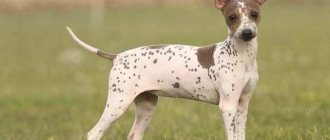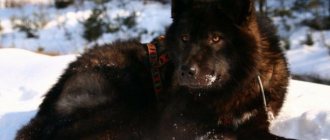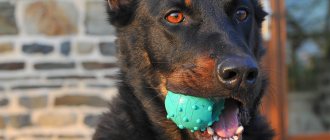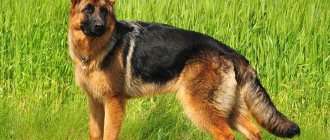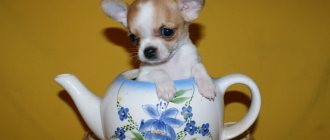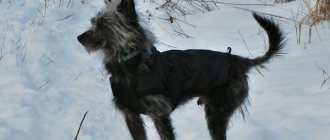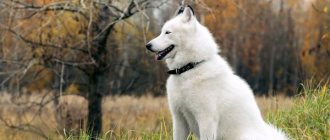The Kazakh Tobet dog breed has been known for a long time. During its existence, it became legendary due to its ability to protect people and animals and survive in difficult conditions. This is national pride for Kazakhstan. The impressive, proud appearance and noble posture make this animal extremely attractive. But it is difficult to maintain him in a city apartment. The handsome Tobets are accustomed to a free life.
Proud Defender
Price
Alabai is considered a unique dog, an exception to the rule.
And before you buy a dog, based on breed standards, you should think twice. After all, even if an animal has ideal external characteristics, expectations may still not be met due to its stubborn disposition. These dogs have a special psyche, unlike anyone else. In addition, the four-legged pet is prone to dominance. The cost of the animal should not be low if we are talking about a dog with a pedigree. And the future owner must trace it. If a private official breeder or nursery values its reputation, then in addition to the pedigree certificate, it will also present other documents for the four-legged animal, including vaccination certificates.
Newly born Alabai puppies
This paperwork makes sense. Thanks to her, it will be possible to choose the best of your breed. After all, no one wants to waste their time on trifles. The price of an Alabai with a pedigree starts from 15 thousand rubles, and the upper threshold fluctuates around 60-70 thousand rubles.
It is ideal if the owners meet the mother and father of the future pet. Usually the rule with Alabai is “similar color - similar character.” If a dog looks like his parents in appearance, then most likely he will resemble them in character. Reviews from breed owners confirm this.
Everyone who has ever opened a browser page with a question about a purchase has come across, in addition to nursery websites, the Alabai Help resource. The creators of the portal themselves state that this is not a shelter, not a nursery or a foundation, but a charitable organization dedicated, in accordance with its name, to helping and saving this breed.
We are talking about dogs deprived of a roof over their heads, left without a home. From this organization you can also purchase a dog for your home, but, of course, most likely it will be deprived of documents, pedigree and vaccinations.
Besides, it's unlikely to be a puppy. But you can do a good deed and save the poor fellow. But since these animals are often taken for protection, a discount can be made on age. The main thing is that the dog is not too old.
What kind of breed is this?
Wolfhound is a dog breed that is divided into many subgroups. We can say that representatives of each individual species of wolfhound are fundamentally different from each other both in character and in appearance. This term is collective for all large and very strong dogs. This name originated in the past centuries, when people hunted wolves themselves, thus protecting their own economy. Only very large dogs could overpower these forest predators. Today, the functions that the wolfhound dog performs in society are not so cruel. They serve in government agencies, are pets of millions of families and do an excellent job as guards.
It is also important to note that over the centuries the general character of these animals has changed. They have become less bloodthirsty, some species are even distinguished by unheard-of kindness, and in this regard they can be compared with Labradors
Education and training
The Kazakh dog needs special education, which begins from the age of several months. She must be socialized and learn to obey. This is a difficult task for an independent and strong dog. But if this is not done, the pet will grow uncontrollable. After all, such Kazakh dog breeds try to become leaders in the pack. The owner must show who the true owner is and only then will the pet begin to obey his authority.
Important! It is necessary to teach the dog to follow simple commands and respond to its name. It is better to entrust training to a specialist.
Origin story
Most of the breeds from the Wolfhound group have been known for thousands of years and have not undergone any changes. It is believed that selection was made on the basis of performance qualities. It was important not only to correctly use one’s massiveness when attacking an animal, but to have a number of useful properties for humans. The domestication of dogs, which are called “wolfhounds,” began with the selection of more obedient representatives. A person needed an assistant where he could not cope on his own. This led to the following being selected:
- stress-resistant dogs with excellent health;
- hardy hunters pursuing prey;
- fearless fighters for property and territory;
- developed sense of a wild animal, which allows the wolfhound to detect prey.
Not all dog breeds are distinguished by excellent obedience, because... It is prohibited in many countries to select qualities for educational ability. It is believed that this spoils the character and natural instincts of a hunter or guard.
Wolfhound dogs have mastiff-like genes and mastiff-like groups in their blood. The ability to do herding work, understanding human commands, and tracking prey indicate increased stability of the body and high intelligence given at birth.
Coming from the East to Europe, they gradually spread, new breeds appeared, and useful habits were developed. When humanity no longer needed to hunt in large quantities, the qualities of protection from the beast gradually began to appear. Today, many dog breeds are considered companions, serve in law enforcement agencies, are reliable rescuers, and security assistants.
The owner of a wolfhound must always remember that the ancient instincts inherent in genetics can manifest themselves at any dangerous moment. Therefore, you need to carefully monitor your behavior.
Where to buy a Tobet puppy
Buying a true Tobet puppy is not an easy task. The breed is very rare. A huge amount of work to revive it is being carried out in the Tobet Kazaky It nursery and some others. In the West they are ready to pay huge sums for a “friendly wolfhound”, but there are not enough puppies for everyone. Complicating the choice of a good puppy is the fact that not all dogs, which their owners call Tobets, meet the requirements of exterior and character. Sometimes similar-looking dogs caught somewhere in the steppe are passed off as Tobets.
According to some data, there are several dozen real Tobets left in Kazakhstan.
Price
On the Internet there are advertisements for the sale of Tobet puppies (mainly on Kazakh websites). The average price is 100,000 tenge (approximately 17,000 rubles).
Recommendations for caring for Tobet
- The wool
is combed more often during the molting period in order to quickly free the tobet from dead undercoat. Water procedures are carried out extremely rarely. - Ears
are checked and cleaned if necessary. - Eyes
do not require special care. - teeth
cleaning from an early age. If this is not possible, then give cartilage and hard sinews of cattle for prevention. - the claws
grow, they are trimmed regularly. - The diet
consists mainly of meat and organ meats, with the remainder including fiber and complex carbohydrates. Additionally, provide your beloved four-legged friend with vitamins and minerals. All natural nutrition can be replaced with ready-made concentrates from well-known manufacturers. Its composition is correctly selected and has an extremely beneficial effect on the body. - Walks
should be long. Of course, it is better to keep the Kazakh wolfhound on private lands, in an enclosure. He must receive appropriate workloads and attend to his direct responsibilities.
Similarities and differences between breeds
When choosing between an Alabai and a German Shepherd, the owner should understand that both breeds have their own advantages and disadvantages. It is necessary to choose an animal based on the purpose of acquisition, the nuances of the pet’s character and maintenance
Before purchasing, it is important to study the description of the breed, take into account all the difficulties of upbringing, disadvantages and advantages of the breed
Appearance
If you look at an Alabai and a German Shepherd mix, you will see that their exteriors are completely opposite. The appearance of the German Shepherd is determined by the breed standards, and the appearance standards of the Alabai are constantly adjusted and supplemented.
The Shepherd is a large, muscular dog, weighing 25–35 kg, height at the withers varies from 55 to 60 cm. The German's muscles are well developed and his physique is strong. Basic coat colors: black, gray, black with red tan. Her appearance vaguely resembles a wolf.
Alabai is not considered a separate breed, but a breed group of dogs selected in Central Asia. Their weight varies from 55 to 65 kg.
Among them, one can distinguish the Turkmen subspecies, which are large animals with spots all over the body. The Tajik subspecies has longer hair and folds on the skin. Animals of the Uzbek subspecies are distinguished by an elongated muzzle. The smallest dog is considered to be the gorse, which can often be found in the northern regions of Kazakhstan. In appearance it resembles a greyhound.
In dog fights, the more agile small Alabais are often pitted against German shepherds. They are distinguished by mobility, endurance and energy. Large Asians are quite clumsy, despite their size and weight, it is difficult for them to fight fast Germans.
Character
The two breeds also differ in temperament. The German Shepherd is a choleric dog, oriented toward its owner and family. She obeys unquestioningly, treats her family with love, but is aggressive towards strangers.
Alabai is more independent, despite his phlegmatic nature, the blood of a wild beast flows in him. In its homeland, such a dog can independently find food for itself while walking down the street, and recognize who is a friend and who is an enemy. He does not obey commands well and prefers to make his own decisions. Dog handlers believe that Alabais have a higher IQ. This dog is not without cunning and ingenuity.
German Shepherds get along better with other animals and cats, but the Central Asian Shepherd does not like other dogs and cats. They have different attitudes towards children: the German is more patient and loves children, the Alabai is indifferent to them. Experts warn that it is not recommended to take Asians into families with small children. At the genetic level, this breed has an instinct to attack smaller creatures.
Maintenance and care
According to reviews from German Shepherd owners, the pet's frequently shedding coat is a big inconvenience. This breed is not recommended to be kept on a chain or in an apartment. When tied to a chain, a dog quickly loses its skills and may develop mental problems. If a German is in the yard, he needs a lot of human attention.
For Alabai, keeping in an enclosure is best. Thanks to its thick coat and thick undercoat, the dog can sleep in the snow without freezing. The large size does not allow keeping the animal in an apartment. The breed is necessary for protecting large territories, just like the Caucasian Shepherd Dog. The German is more suitable for protecting the family.
The enclosure must be strengthened; the fence around the house must be high. The dog has a tendency to run away. He can easily jump over a fence or dig under a hole.
Training and education
Central Asians are trained worse than Germans. They can do what the owner wants, but not blindly obey commands. Their behavior during training resembles that of a child. The animal must be motivated and interested.
The Germans train with pleasure for the sake of ordinary praise, but training Alabais is much more difficult. It's better to leave this to a professional. A specialist will help build a clear hierarchy in the dog’s head.
Who is stronger: Alabai or German Shepherd? The Asian is larger and stronger than the German, but he is clumsy and clumsy. Dog handlers note that when trained, the German attacks head-on. Alabai uses more cunning moves, attacking unexpectedly or from behind. He also uses a similar behavioral strategy in dog fighting.
Health
Central Asian Shepherds are considered an aboriginal breed, so they practically do not suffer from infectious diseases and do not have genetic abnormalities. Germans are more susceptible to diseases of the gastrointestinal tract and otitis media. They may have problems with their hip joints.
History of appearance and origin
Kazakh tobet has been known since 1121 BC. It was distributed in the territory from the Far East to Eastern Europe. It was there that the remains of a unique breed were found.
A dog of the Tobet breed lived at the court of the Khan. It was there that they bred the breed. The nomadic way of life put forward strict requirements that the animal must meet. And Tobet was just such an animal. Since childhood, he got used to harsh climatic conditions, constant movement (a feature of nomadic life); the four-legged friend learned to herd cattle and protect it from wild animals, with which, if necessary, he would fight without hesitation.
An interesting fact is that the Tobet dog is considered the savior of horse-nomadic civilization. Giant animals lived hand in hand with nomadic tribes. They were fed from bowls that were lined with wolf skin on the inside. So the wolfhound got used to the smell of the wolf from childhood. And as an adult, he entered into a fight with him: the confrontation between a wolfhound and a wolf always ended not in favor of the latter. Indeed, a fight against a wolf will not only be able to resist, but also force the predator to flee.
There is a version that the breed was originally called “Kazakh it”, which meant Kazakh dog. Later the Turkmens called it “Turkmen alabai”. Well, from time immemorial, the Kazakhs called it tobet for their own people, and alabai for strangers.
Today, the population of the Tobet breed in Kazakhstan has greatly decreased. The wolfhound is on the verge of extinction - out of tens of thousands of heads, only a dozen remain. Breeders support the breed as best they can without mixing it with others. So, for breeding they take dogs whose ancestors are known up to the 10th-15th generation.
Interesting Facts
You can find many interesting facts about the life of the Tobets. Here are a few of them:
- When a sheep gives birth to a lamb, several dogs remain on guard, while the rest continue to look after the grazing flock.
- Young female Tobets have their tail and ears trimmed a few days after birth. This will protect them from injury when attacked by wolves.
- The tails of male dogs are left untouched so that the difference between the sexes of the dog can be seen. In addition, for a proud male, a raised tail is a symbol of superiority over other animals.
- In ancient times, wolfhounds were fed from bowls covered with wolf skin. This taught us from an early age not to be afraid of the smell of a predator, perceiving it as accessible prey.
A dog like the Kazakh Tobet has long become legendary. Despite its large size, it is not scary for humans. Smart and responsible wolfhounds will become helpers in the household and good friends with proper care.
How to choose a puppy, its cost
Wolfhounds are serious dogs for whom it is important to be courageous, courageous, and mentally balanced. Therefore, you need to be very careful when choosing a puppy.
Therefore, you need to be very careful when choosing a puppy.
- Decide on a nursery or breeder of the breed.
- Make sure that the parents have all the documents.
- Ask to see pedigrees and any awards for achievements in the breed if they have taken part in exhibitions.
The puppy must have a veterinary passport and a puppy card. It is worth considering if the breeder is a reseller. An honest owner has nothing to hide. You need to look at the puppy’s mother, ask about the characteristics of the breed and feeding. If you evade questions in any way, you must refuse and look for other options.
Among the wolfhounds there are very cute puppies. You can’t take it just because you liked it from the photo. The choice should take into account the breed inclinations and lifestyle of the future owner.
A healthy puppy stands firmly on its limbs, does not fall over or stagger. He is keenly interested in what is happening around him and does not react to loud sounds with stressful behavior (running away, getting angry, whining). There is no discharge from the natural openings, which is a sign of health.
The price of a wolfhound depends on the rarity of the breed, the number of competitors at exhibitions, and breeding planning. It starts from 200 USD. and ends with more than 2.5 USD. On average, a popular dog breed can be purchased for $500.
Choosing a puppy
It is quite difficult to purchase a purebred Kazakh greyhound puppy, since their population is extremely small. Basically, all large nurseries are located in Asian republics (former Soviet ones), and this is where you need to go. It is recommended to first look at the parents during work if you intend to use the dog for its intended purpose. A pedigree certifying the origin of the baby is required.
It is very difficult to distinguish a Tazy puppy from other greyhound puppies
It is quite difficult to distinguish a small Tazy from other related breeds or simply visually similar animals; this can only be done by an experienced dog handler specializing in greyhounds. However, there are several characteristic signs:
- a long and dry head with the least pronounced stop (the transition from the forehead to the nose);
- long-legged and lean, noticeable already from 1.5–2 months;
- Hanging and thin ears are rather low set.
Kazakh greyhound puppy price
Despite their rarity, basins are not considered expensive. You can buy a puppy with a decent pedigree for 15–25 thousand rubles. A baby deprived of regalia and documents will cost 3–5 thousand rubles.
How to properly care
Alabai care includes:
- regular feeding. Food should be balanced, appropriate for the dog’s age, and contain many vitamins;
- periodic combing and haircuts. If the dog does not live in the north and does not need a thick skin, it can be cut, but the coat will have to be combed constantly;
- vaccinations. Like any animal, Alabai needs vaccinations, for example, it needs to be vaccinated against rabies;
- walks. If the yard is small and there is not enough space for the dog, then you will have to constantly walk the Alabai; without walks, he will get bored, become lethargic and inactive.
Regular mating of animals during estrus and subsequent care of puppies are also important.
Note! The Alabai can spend most of the year in an open enclosure; its fur coat protects it from both cold and heat. But it’s better to build a dog house
Features of caring for bitches
The first heat occurs in Central Asian Shepherds at the age of 2 years, but usually breeders do not recommend breeding dogs at this time; it is better to wait at least 1 year. This will avoid multiple pregnancies and miscarriages.
Estrus time is August-September. Estrus occurs once or twice a year, the best time for mating is the end of winter. Pregnancy lasts 60-65 days. You can recognize it by the presence of discharge from the loop, which appears in the third week after mating.
Important! During pregnancy, bitches become aggressive and need increased nutrition; food should be rich in vitamins. Childbirth in most cases goes smoothly
If the bitch is young and there are a lot of puppies, then you should expect them to appear a few days earlier
Childbirth in most cases goes smoothly. If the bitch is young and there are a lot of puppies, then you should expect their appearance a few days earlier.
Feeding a bitch during pregnancy requires a large amount of vitaminsNutrition
It is better to find out what the alabai eats directly from the breeder. Typically dogs of this size are fed:
- special feeds;
- porridge;
- bones;
- meat;
- fish.
An Asian dog's daily diet must include boiled and fresh vegetables and vitamins. You need to feed 2-3 times a day, the dog needs a lot of food, but should not be allowed to become obese. There must be fresh water in the bowl.
Walk
Alabais are walked on a leash and muzzle, like most dogs. Children and elderly people should not be entrusted with walking dogs; if the dog is not sufficiently trained or feels like a leader, then it can snatch the leash from a person’s hands and run away in pursuit of a cat or another dog. If the dog is not trained, walk it only away from residential buildings and people. Central Asian shepherd dogs are released into the urban environment on a leash and in a collar only after they have mastered basic commands.
Important! Walk frequently, at least twice a day. The dog needs constant movement, it is not a chain dog, a purebred Alabai needs space
Features of feeding and diet
Proper nutrition for your pet is the basis of its health. This is especially important if the dog is large and prone to weight gain. Therefore, the number of calories should be sufficient for the normal functioning of the pet, but nothing more.
The daily diet should include:
- Fresh meat.
- Various cereals.
- A little bran.
- Fruits and vegetables.
- Dairy products.
For such an animal, about 2.5 kg of food per day is enough. The bowl is fixed on a stand, which is adjusted as the puppy develops, maintaining its correct posture.
It is better to feed young dogs with meat that has been previously ground into minced meat and stored in the freezer. This kills parasites. Cottage cheese is given to strengthen bones. Bones, sweets and leftover food are strictly prohibited.
You can use ready-made food containing all the necessary microelements and vitamins. But at the same time you need to choose a quality product that will be balanced.
Important! Food temperature should be room temperature. This will eliminate stomach problems.
Character
During the selection process, the Alabai developed the main quality - the ability to stand up for itself and those it protects. These skills make the Central Asian an excellent shepherd and fighter, but it is not suitable for everyone as a pet. The Shepherd Dog from Central Asia has a very aggressive temper and tends to dominate. Separately, it is worth noting the nobility of this breed. It lies in the reluctance to finish off a defeated opponent. Therefore, only those who know nothing about the character of an Asian can say that a pit bull terrier will easily defeat an Alabai. A shepherd dog, of course, can instantly deal with such an opponent due to its physical advantage, but as soon as it sees that the pit bull is weaker, it simply stops the fight.
Alabai, without proper training, rushes at any strange dogs. He is neutral towards those who live with him. It usually does not attack people, but is wary of strangers. A wolfhound will not bite a stranger unless he poses a threat. It is sensitive to the mood of the owner and his family members, so this breed is not suitable for cruel people with an unstable psyche.
Central Asian Shepherds treat children much better than Caucasians, especially those with whom they live in the same territory. A competently trained Alabai is a reliable friend of the owner, very attached and devoted to him. This is a strong and brave dog, which does not rush into a fight unnecessarily. In addition, she is very hardy and unpretentious in everyday life.
Varieties of Alabaev
Wolfhound subspecies have been selected in almost all Asian countries. They have some differences, depending on their habitat, but family ties are clearly visible.
Here are the most famous types:
- Tibetan mastiff. A rare and expensive dog that can survive in harsh conditions. Mastiffs are tall and powerful, with thick hair in the neck area that extends into the mane. They are calm, with a rather gentle character and love children, but you should not leave them alone.
- The Turkish Kangal is one of the most ancient breeds. Very obedient, kind, hardy and brave, but at the same time distrustful. Gets along well with other pets. Most often used for protection.
- The Uzbek Buribasar stands out from other Asians due to its smaller size and elongated muzzle. An easy-going dog with developed intelligence.
- The Siberian Alabai is a cross between a German Shepherd and a Siberian Husky. Obedient, smart and sociable.
- The Afghan Alabai is very strong and is often used for hunting. It is not recommended to keep him with other pets. Extremely willful, takes a long time to get used to people.
- The Alaskan Malamute is wolf-like in appearance, hardy and friendly, but can be stubborn. Dogs are used to transport goods, and not as guards, because they are absolutely devoid of aggression.
- The German Alabai is a cross between an Indian wolf and a German dog. Very smart, senses danger, fearless and mentally stable.
- The Armenian Gampr has a distinctive external feature – powerful jaws. He becomes very attached to a person if he proves his dominance.
- Kazakh tobet is the least common today and is on the verge of extinction. They are strong and unpretentious.
- The Kyrgyz debit is another endangered species of alabai. In the eighties of the last century, they were actively destroyed because they were considered spreaders of rabies.
- The Tajik Alabai is the largest and resembles a St. Bernard, good-natured and reserved.
The Turkmen Alabai is taken as the basis for the characteristics of the modern factory breed. Most of all, he is similar in psychotype to another representative of wolfhounds - the Caucasian Shepherd Dog. It is impossible to say with certainty which of them is stronger. Alabais are slightly larger and more massive, but less stubborn and aggressive. Here it is worth taking into account the tasks set by breeders when creating breeds. If a Caucasian is aimed at destroying the enemy, then the shepherds rejected dogs that attacked the owner. Asians are characterized by a clear division into friends and foes.
The Alabai breed standard was first registered only in 1989. In 2010, changes were made to it, in particular, the maximum permissible height of a shepherd dog was increased by 5 cm. Currently, Alabais are in demand in the security field, so very stringent requirements are imposed on selection and training.
Brief historical background
The true origin of Afghan hounds is shrouded in darkness and hidden in the depths of centuries. The breed is considered very ancient, but at least the approximate date of its origin is unknown to anyone. Scientists dated rock carvings of canids, which have a strong visual resemblance to Afghans, found in Iranian caves to the 9th-10th centuries BC. Similar drawings were also discovered in the east of Afghanistan; they were painted later - in the 2nd century BC. e.
Dogs of this type lived in the vast steppe and semi-desert territories of South and Central Asia, in the mountainous areas of the Tien Shan and Pamirs. According to some studies, the closest relatives of the Afghan hounds are the Saluki, the oldest native Middle Eastern breed, whose history goes back several thousand years. There are two main types of greyhounds (in fact, there are about 13 of them in Afghanistan alone):
- mountain - with long hair that protects from harsh climates;
- steppe - with a rather short coat.
The animals were used by local residents to hunt various game and also as guards and were especially valued for their running speed, tirelessness and ability to persistently and recklessly pursue prey.
The modern history of the breed begins at the very end of the 19th century, when its first representatives were brought to England by British officers returning from Persia, India, and Afghanistan. Animals participated in various exhibitions and competitions as exotic novelties. A dog named Zardin (owner - Captain Bariff), who won many (more than 50) victories in similar competitions, entered the annals of history. His appearance formed the basis of the first breed standard (1925). At the beginning of the 20th century (20s), there were two competing nurseries, in one of which Pakistani animals with relatively short hair were bred, while in the other, preference was given to long-haired people from Afghanistan. The modern appearance of the Afghan Hound was formed by crossing these lines.
The Zardin dog is considered the ancestor of all modern Afghan hounds.
The breed was registered with the FCI (Federation Cynologique Internationale) in 1965. The final version of the breed standard was approved in June 1987 at the Jerusalem General Assembly. The current document is dated December 12, 2011, the breed is included in group 10 - greyhounds, section 1 - long-haired greyhounds or greyhounds with hanging hair under No. 228.
Breed standard
When you look at a tobeta, you can see its strength and power. The animal's height is about 75 cm at the withers, and its weight reaches 60 kg. Distinctive features of the breed are:
- The head is large with a powerful, slightly flat skull. The broad forehead and well-defined eyebrow line stand out on the short muzzle.
- The jaws and teeth are large. Moreover, the lower jaw is slightly wider than the upper. The upper lip is thick enough to cover the lower lip and form the so-called jowls.
- The nose is wide.
- Medium sized eyes with a smart expression.
- The ears are small and triangular in shape. As a rule, they are docked.
- The neck is quite powerful with a well-formed dewlap.
- The body and chest are well developed. The back is elastic with a wide loin. The stomach drops quite low.
- The limbs are low, but muscular.
- The tail has a edge and is not set too high. In bitches it is stopped.
- The coat has a dense undercoat, rough and close to the body. It is waterproof and has medium length.
- The color can be solid or colored, with the predominant colors being black, grey, white and red.
Disqualifying defects of an animal:
- inexplicable cowardice, aggression, apathy;
- lack of teeth;
- weak joints;
- imbalance of movements;
- malocclusion.
Important! Males should have pronounced and well-developed reproductive organs.
Vaccinations for Kazakh greyhounds
Vaccination is carried out against the following diseases:
- canine distemper or distemper;
- parvovirus enteritis - the causative agent is parvovirus;
- infectious hepatitis - causative agent hepadnavirus;
- parainfluenza;
- rabies;
- leptospirosis;
- coronavirus;
- trichophytosis.
- At 2 months the first vaccination is carried out. After the injection, the puppy should not be washed, overfed or taken outside. Immunity after the first vaccine is developed within 12 days; this period becomes the most dangerous for the baby. A person needs to make a lot of effort to alleviate the puppy’s condition. After the first vaccination, puppies experience increased body temperature, general weakness and diarrhea.
- After 3 weeks, the puppy is given a second vaccination, but with the same vaccine. As a rule, after the second vaccination the dog feels much better, but for 12 days it must be protected from other animals, from drafts and not taken out for walks. After this time, walks are allowed.
- At 6 months of age, the puppy is vaccinated against rabies and a complex vaccine against several diseases. It is forbidden to vaccinate if the dog's teeth are changing. You need to wait until all the teeth are replaced, and then vaccinate the baby.
- At one year of age, the dog is given a comprehensive vaccine.
- Further, once a year the dog should be vaccinated with the same complex vaccine.
Only a qualified specialist should vaccinate a puppy.
Before vaccination, he must examine the dog, measure its body temperature, and only if everything is normal, give the injection. The vaccine is placed either in the scruff of the neck or in the hip of the dog. The entire list of vaccinations administered by the veterinarian must be recorded in the dog’s passport. It also indicates the date of vaccination; subsequently, the owner himself will know the expected date of the next vaccination.
Mating
Estrus (or, as it is also called, the first mating) occurs in a dog at one year of age. A female usually has a void twice a year, but there are also cases when a greyhound has a void once a year or every 2 years. In this case, the female can be mated only at one and a half years of age. Until this time, she is not yet developed enough to whelp.
If you refuse to mate, after a week of emptying, you need to lock the female in a safe place for 15 days, and take her out for walks only on a long narrow belt. This will not harm the dog, since whelping makes the dog's body weaker, which leads to premature aging.
Behavioral specificity
The Turkmen wolfhound has a number of other behavioral features. It would seem that a character formed in the vast expanses of mountains, deserts and semi-deserts should be particularly aggressive. In these open spaces, people and livestock were in danger from natural disasters, the fangs of other predators, and most importantly, from other people. After all, in these parts there have long been robbers who traded not only in the theft of livestock and property, but also in the slave trade.
However, this dark past strangely affected the character of the Alabais, especially the Turkmen ones. If these dogs are close to the flock and their owners, then an approaching stranger will be stopped by a moderate, non-aggressive bark. This is just a warning that continues until the owner finds out what the person came with. If the situation is peaceful, then the Alabai will never show aggression towards a new person, allowing him to be in the given territory unhindered.
So these dogs have a generally positive attitude towards people. However, only until the person came to them in peace.
It’s another matter if these Alabai do not have a nearby object of protection and the will of the owner to guide them. In small Turkmen villages, where it is not customary to keep chain dogs, Alabais gather in packs and begin to guard the village itself, controlling its perimeter.
If suddenly, under the cover of darkness, when the inhabitants of the village are sleeping, a random traveler enters this territory, then the Alabai will receive him in their own way. A well-coordinated flock surrounds such a person, trying to get behind him. If the traveler’s nerves are strong and he does not run, then a characteristic carousel will form. The man, turning to face each of the dogs, constantly spins in place. Each dog, trying to get behind his back, is forced to run in a circle all the time. We must give these dogs their due, such a carousel does not last long. If it turns out that a person has strong nerves, does not use weapons, does not call for help, then the pack, with a sense of fulfilled duty, runs away on its security duties.
History of appearance and origin
Kazakh tobet has been known since 1121 BC. It was distributed in the territory from the Far East to Eastern Europe. It was there that the remains of a unique breed were found.
Tobet, the Kazakh wolfhound, was described in the books of Marco Polo. “The Book about the Diversity of the World” tells about the life of the Kazakhs and about their faithful helpers - large “donkey-height” wolfhounds. There are also pictures depicting large assistance dogs.
A dog of the Tobet breed lived at the court of the Khan. It was there that they bred the breed. The nomadic way of life put forward strict requirements that the animal must meet. And Tobet was just such an animal. Since childhood, he got used to harsh climatic conditions, constant movement (a feature of nomadic life); the four-legged friend learned to herd cattle and protect it from wild animals, with which, if necessary, he would fight without hesitation.
An interesting fact is that the Tobet dog is considered the savior of horse-nomadic civilization. Giant animals lived hand in hand with nomadic tribes. They were fed from bowls that were lined with wolf skin on the inside. So the wolfhound got used to the smell of the wolf from childhood. And as an adult, he entered into a fight with him: the confrontation between a wolfhound and a wolf always ended not in favor of the latter. Indeed, a fight against a wolf will not only be able to resist, but also force the predator to flee.
There is a version that the breed was originally called “Kazakh it”, which meant Kazakh dog. Later the Turkmens called it “Turkmen alabai”. Well, from time immemorial, the Kazakhs called it tobet for their own people, and alabai for strangers.
Today, the population of the Tobet breed in Kazakhstan has greatly decreased. The wolfhound is on the verge of extinction - out of tens of thousands of heads, only a dozen remain. Breeders support the breed as best they can without mixing it with others. So, for breeding they take dogs whose ancestors are known up to the 10th-15th generation.
Tobeta is also called the “sleeping dog.” It is believed that when he sleeps, he accumulates strength to fight the wolf.
Maintenance and care
The breed is adapted for life in natural conditions. It easily tolerates sudden temperature changes. Subcutaneous fat and thick hair allow you to maintain the desired temperature balance even in a snowstorm. If there is no water or food nearby, the dog will not die from dehydration or exhaustion. She uses her own fat reserves to survive. She simply needs space and the ability to move a lot. Therefore, you cannot keep such a dog in an apartment. The ideal option would be to keep the Tobet breed (Kazakh wolfhound) in your own home. It is easier to create the necessary conditions for such a large dog.
Walk with the owner
Origin story
This hunting dog of the peoples of Central Asia has been known since ancient times. It is believed that it was bred many centuries ago on the basis of the Persian Saluki, Arabian servant and the ancestors of the Pharaoh's dog, to which the blood of local dogs was added for rapid adaptation to different conditions and climate. Tazy are widespread mainly in Turkmenistan, Kazakhstan, Uzbekistan, single specimens are found in large cities of Central Russia, among rural hunters of the Stavropol, Krasnodar Territories and Volga region, as well as in the countries of Central Europe.
Tazis are national pride, the heritage of the Kazakh people. At one time they saved entire villages from starvation. With a dog you can go hunting for hares, corsacs, foxes, as well as roe deer, saigas and goitered gazelles.
In the Soviet years, the breed attracted researchers, so A.A. Slutsky compiled the first official description of the Taza and in 1939 published the book “The Asian Greyhound Taza and Hunting with It.” According to the scientist, there were several tens of thousands of greyhounds on the territory of Kazakhstan. The breed is recognized by the Union of Cynologists of Kazakhstan and cynological organizations of some other countries.
In 2014, a standard was developed and recognized.
The President of the National Club of the Kazakh Tazy breed noted that its recognition by international organizations should save the breed from degeneration. Today, Kazakh dog breeds are on the verge of extinction, especially Tobet, because they are bred only by amateurs. In addition, there is a very fine line between the Saluki and Tazy breeds. In some countries, for example in America, all Tazis are registered as Salukis.
Purpose
Like other greyhounds, Tazy hunts according to the “catch and kill” principle. These dogs are designed for running and unarmed hunting.
Moreover, very often they are afraid of being shot. Specimens that respond well to loud noises can retrieve prey from the water, but do not do so as passionately as a spaniel or retriever. Tazy have a good sense of smell; they prowl freely in front of the hunter, independently identify the animal and rush after it in pursuit.
The element of tazy is running. These dogs chase everything that moves.
The main subject of hunting from the tazy remains the fox, hare, polecat, and badger. Several dogs can drive away a hoofed animal and a wolf. It is worth noting that for hunting wolves, the tazy are too small and often do not survive fights with the gray predator. When hunting, tazy animals use their eyesight, but they also follow the scent well, using their sense of smell, and show a tendency to fetch.
Taz hunters claim that these dogs never crash into obstacles, as happens with other high-speed breeds. Some amateurs use basins in joint hunting with a bird of falcon. The greyhound must be greedy for the animal, maneuverable, resourceful, have speed and have a good grip.
Video about the dog breed Tazy (Kazakh Greyhound):
Temperament and use
Tazy dogs are self-sufficient and independent, they are not inclined to show aggression towards strangers, but they strive to maintain a distance even in relation to the owner. The agility, endurance and vigilance of the tazy are combined with good instincts, anger towards the animal, maneuverability and the ability to fetch. Taz can run for a long time at a speed of 12-15 kilometers per hour, and when chasing prey they can reach much higher speeds. Although hunting abilities and the instinct to pursue fleeing game are fixed in the breed and are inherited, not all Tazy are born with sufficient malice towards the animal. Therefore, from the age of six months, puppies are attracted to joint hunting with adult dogs and in packs.
History of the breed
In Mesopotamia, Central Asian Shepherds were used as fighting dogs. They are closely related to the Tibetan Mastiff. The selection, both natural and human, was extremely cruel. Only the smartest and strongest puppies were left alive, who could pass on these qualities to their offspring. Harsh living conditions strengthened the dog’s character; the need to constantly fight predators changed its appearance (the body became lean, powerful, the head was large, resistant to impacts, and the coat was voluminous).
Pair of male and female
Due to the fact that the Alabai was bred throughout Asia, many varieties of this breed appeared, and a large number of interesting facts related to it accumulated:
- in Turkmenistan, the alabai is considered a national treasure; it is forbidden to export it outside the country, as if it were not a dog, but a work of art;
- from Uzbek the term “buribasar”, which is used to refer to a shepherd dog, is translated as “wolfhound”;
- Kazakhs call the dog “tobet”, which means “dog on the top of the hill”.
For your information! During the Soviet era, around the mid-1930s, Central Asian Shepherd Dogs began to be bred by state breeders. It was supposed to involve Alabai to guard the state border, work in the authorities, and search for criminals. But it turned out that the dog was almost impossible to train, mass training led to disastrous results, and the project was canceled.
Adult dogs are difficult to train
Character
The breed has the characteristic of being intelligent, intelligent and loyal protectors. Unlike other wolfhounds, the Tobet is friendly towards strangers. If there is an owner nearby who shows no signs of concern, the dog will allow the guest into the territory and will even politely wave its tail. But he can only go out if the owner gives the command to let him through.
And, of course, such a wolfhound will never offend a child, no matter how much he pisses him off. It seems as if this is the most melancholic animal, but the speed with which the powerful alabai gets to the right place is simply amazing. One such dog is enough to protect the herd. The wolves do not risk approaching when they hear her voice. They understand that this force can not only stop, but also destroy.
When you need to be patient a little
Health and illness
Tobet has good immunity. But the owner must try to maintain health by monitoring his diet and getting vaccinated against various infections. This is a mandatory procedure. The main problem for dogs is joint diseases. To avoid this, you need to consult a veterinarian who, unlike the owner, understands the dangers of obesity.
Important! Dysplasia affects most large breeds. The cause of the disease can be errors in feeding and high weight.
